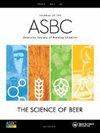两批浓香大曲的环境理化特征及真菌群落
IF 1.8
4区 农林科学
Q4 BIOTECHNOLOGY & APPLIED MICROBIOLOGY
Journal of the American Society of Brewing Chemists
Pub Date : 2021-09-21
DOI:10.1080/03610470.2021.1968230
引用次数: 0
摘要
摘要对两批浓香大曲在发酵期和贮藏期的环境、理化特性及真菌群落进行了研究。大曲于2018年7月1日和2018年8月1日加工,分别被鉴定为中温大曲和中高温大曲。在属水平上,优势真菌是发酵阶段的曲霉菌和储存三个月后的念珠菌。主成分分析(PCA)和算术平均的未加权配对群法(UPGMA)分析表明,真菌群落根据发酵和储存阶段可分为两个主要类群。然后,每个大型真菌种群可以根据批次分为两个较小的组。值得注意的是,LEfSe[线性判别分析(LDA)效应大小]分析没有发现两个批次之间有任何显著差异的真菌种群。冗余度分析表明,在两批大曲的整个培养阶段,水分含量和发酵力与曲霉菌和Wickehamomyces呈正相关,而水分含量与根霉呈负相关。发酵过程中,环境湿度与两批大曲中的Wickehamomyces呈负相关。本研究增加了对大曲制剂的理论认识,特别是对大曲贮藏期的作用和不同批次大曲的真菌差异的认识。这些信息有可能通过加工条件和添加念珠菌来控制真菌群落,从而提高大曲的质量。本文章由计算机程序翻译,如有差异,请以英文原文为准。
Environmental and Physicochemical Characterization and Fungal Community of Two Batches of Chinese Luzhou-Flavored Daqu
Abstract The environmental and physicochemical characteristics and fungal communities of two batches of Chinese Luzhou-flavored Daqu were investigated during the fermentation stage and storage period. The Daqu was processed on July 1, 2018 and August 1, 2018, and was identified as middle-temperature and middle and high-temperature Daqu, respectively. At the genus level, the dominant fungi were Aspergillus during the fermentation stage and Candida after three months of storage. Principal component analysis (PCA) and the unweighted pair group method with arithmetic mean (UPGMA) analysis revealed that the fungal community could be divided into two primary groups based on the fermentation and storage stages. Each large fungal population could then be divided into two smaller groups according to the batch. Notably, LEfSe [line discriminant analysis (LDA) effect size] analysis did not find any significantly different fungal populations between the two batches. Redundancy analysis showed that during the entire culture stage of two batches of Daqu, water content and fermenting power were positively correlated with Aspergillus and Wickerhamomyces, while water content correlated negatively with Rhizopus. During fermentation, environmental humidity correlated negatively with Wickerhamomyces in the two batches of Daqu. This study increases the theoretical understanding of Daqu preparation, especially function of the storage period and the fungal differences between batches of Daqu. Such information potentially enables the quality control of Daqu in order to improve quality by controlling the fungal community via the processing conditions and the addition of Candida.
求助全文
通过发布文献求助,成功后即可免费获取论文全文。
去求助
来源期刊

Journal of the American Society of Brewing Chemists
工程技术-生物工程与应用微生物
CiteScore
4.00
自引率
20.00%
发文量
41
审稿时长
3 months
期刊介绍:
The Journal of the American Society of Brewing Chemists publishes scientific papers, review articles, and technical reports pertaining to the chemistry, microbiology, and technology of brewing and distilling, as well as the analytical techniques used in the malting, brewing, and distilling industries.
 求助内容:
求助内容: 应助结果提醒方式:
应助结果提醒方式:


